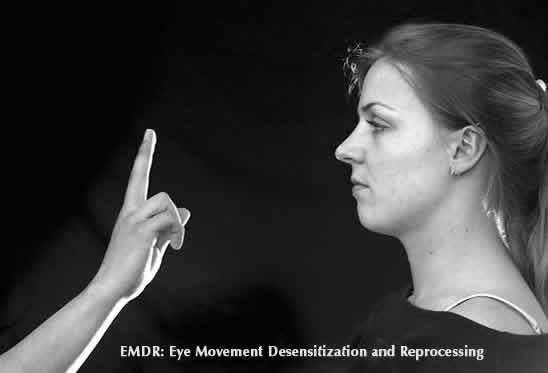It may seem like a ridiculous claim, but it has been claimed that eye movements can help us to heal our traumas. Which therapeutic paradigm does this kind of treatment fall under and is there any truth to this claim that eye movements can help process trauma?
In short, it is indeed true that eye movements can help people to overcome trauma. Through a now well developed and validated therapeutic process called Eye Movement Desensitization and Reprocessing or EMDR, lateral eye movements or other forms of stimulation can be used in a way helps the mind/brain “digest” or process trauma and make peace with unpleasant past experiences. Let’s look in more detail at the EMDR process and some possible explanations for the role eye movements play in the treatment.
EMDR Explained – in 2 Minutes
The lateral eye movements involved in EMDR can stimulate the mind to process trauma in a very effective way
What is EMDR?
We have briefly explained what EMDR is in a nutshell above, but we will go into a little more detail in this section. It is a therapeutic technique founded and developed in the 1990s by Francine Shapiro in which eye movements play a central role in helping patients to process trauma in their lives.
The full process however involves much more than just eye movements. See our article on the 8 step process of EMDR for a full breakdown, but we will summarize it quickly here.
Firstly, the patient and therapist will draw up a detailed history of the person’s life, including significant traumatic events. These experiences will be organized into logical groups or classes of experience which can be described as broadly similar, such as humiliation, rejection, physical abuse and so on. Key standout events in each class will be identified as the experiences that will be targeted in the therapy.
The therapist will then attempt to tap the patient back in neurologically to a specific standout memory or an unpleasant experience, attempting to rekindle (as much as possible) the same feelings, emotions, physiological sensations as they felt at the time it initially happened.
Whilst this may seem like a counter-productive thing to do for some – why make people re-experience a horrendous trauma? – it is actually key to the process of ultimately letting it go. Tapping back in neurologically to it allows it to then be digested and processed with EMDR therapy, at which point it can truly be left behind. As the saying goes, “what we can feel, we can heal“.
Once the memory is fully re-activated and re-awakened in the person, then the therapist will provide them with some kind of bilateral stimulation for them to focus their attention on. This most often involves back-and-forward hand movements that the patient follows with their eyes – hence the name EMDR – but other kinds of stimulation such as audio or tapping can also be used. Eye movements are generally considered most effective though.
Is EMDR Effective?
Through this process of staying in tune with the re-awakened memories and feelings of a trauma, whilst also following some kind of stimulus back and forward with their eyes, EMDR has now been well established to have remarkable healing effects in helping patients process and let go of a traumatic experience which may have been bothering them for years in some cases.
EMDR has been proven to be effective in dealing with all kinds of trauma, to the point where it is an officially recognized and recommended treatment for trauma by the World Health Organization. There is also growing evidence it can treat other conditions like anxiety, depression and phobias.
People report a number of benefits, sometimes within minutes of the treatment occurring. In general, they report that there is great deal less distress in revisiting the trauma in their minds. It is as though the “sting” has been taken out the memory; they are still able to remember the basic facts of what happened but the memory is no longer so troublesome or traumatic to recall.
They also report feeling more internally “distant” from the memory, whereas before it may have still seemed very vivid and real, perhaps as though it still happened yesterday even if it happened many months or years previously. It is now just another memory rather than something which was a constant source of distress they may have constantly felt the need to avoid or push to the back of their mind.
In short, it seems as though the use of eye movements stimulates the mind/brain to process or digest the memory in way it couldn’t do at the time of the initial trauma, for whatever reason. It is a way of going back over and re-working the memory and associated feelings to take the intensity out of it and reduce the power it has over the person in the present.
Competing Theories as to Why EMDR Works
Why Do Eye Movements Have This Effect?
But why is it that eye movements in particular seem to have such a radical effect on processing trauma? What is it specifically about moving one’s eyes back and forward whilst also tapped in neurologically to trauma that has such a profound healing effect on patients?
The short answer is that experts are still not 100% sure exactly how EMDR has such as powerful effect on trauma. The fact that it is effective is in no doubt from the huge body of academic and anecdotal evidence now; experts are just not totally certain how or why it is so effective. There are a couple of logical explanations which make sense though.
The first explanation is known as the REM hypothesis and holds that EMDR is effectively replicating what happens to us anyway during Rapid Eye Movement or REM sleep. It is the explanation that EMDR founder Francine Shapiro leans towards. REM sleep is a particular phase of our sleep when our eyes move backwards and forwards very rapidly. It is the phase of sleep where we tend to have dreams.
Researchers have discovered that during REM sleep, the person’s memory is effectively cleaned up or “pruned”, as the mind/brain effectively does it’s own job of working through recent memories and deciding what to keep and what to discard.
REM sleep effectively facilities our mind to do it’s own spring clean or detox and digest or hold onto what it needs to and discard what it doesn’t. Without this cleaning up phase we would just be overwhelmed with the accumulative effect of all memories and associated feelings we have ever experienced. The mind needs to have a process whereby it decides what to hold onto and what to let go of.
It has therefore been argued that EMDR is basically stimulating the mind/brain to do the same psychological digesting process as during REM sleep, but instead the patient and therapist are doing it consciously and wakefully, and specifically choosing the memories to target and work on.
Here are links to two studies investigating this REM sleep hypothesis for EDMR:
- Stickgold (2002) on the REM sleep effect of EMDR on the processing of memories.
- Stickgold (2008) on the effect of REM sleep and bilateral stimulation in the processing of memories.
REM sleep and dreaming are of course more random and the person has less control over which memories are digested through this process. EMDR is a more conscious and intentional process but the theory goes that the eye movements involved are effectively replicating the eye movements during REM sleep and stimulating the mind into performing the same function as it would during this process.
This allows for the conscious targeting and processing of memories which, for whatever, reason, the person could not adequately process at the time it happened. Perhaps it was simply too traumatic to deal with initially or maybe the person suffered a series of traumas in quick succession and their mind simply became overwhelmed and lost it’s ability to process all the experiences.
EMDR is way of consciously kick-starting this digestive process back up and loosening up traumatic energy which is still stuck in the mind and body. The eye movements serve to stimulate the mind to do what it couldn’t do at the time the trauma was experienced and once processed the experience can be let go of by the patient.
Another explantion is for the effectiveness of EMDR is the working memory hypothesis, which states that the eye movements in EMDR serve to blur the vividness of a memory by effectively partially distracting the mind from it once it is brought into short term memory (working memory) through the EMDR process. This perspective on EMDR is very well summarized in the 2 minute video embedded at the top of the article.
The eye movements performed during EMDR are effectively a form a bilateral stimulation, where in having to follow an object such as the therapist’s hand backwards and forwards, the brain is being given a job to do and the left and right hemispheres of the brain are stimulated in succession as the client tracks the hand movements left and right and back again.
This along with the client focusing in on the internally activated memory/feeling of a past traumatic event, creates a dual focus of attention, where they are focusing not just on the internal or the external but on both the internal (memory of an event) and the external (hand moving backwards and forwards or some other bilateral stimulation) at the same time.
The theory goes that this effectively blurs or lessens the charge of the activated memory, which through the therapeutic process has now been brought out of long term memory into short term or working memory. It now feels “live” and visceral again to the client.
If you “catch” the memory whilst it is still in the working memory with the hand movements or other outer stimulation then the mind/brain now has something else to focus on as well as the traumatic memory, and this serves to lessen the intensity of the memory. It is “blurred” and becomes less vivid through the EMDR process and the client is now far less bothered by it than before.
The dual focus of attention part is most important to emphasize here, as it is a crucial aspect of what makes EMDR successful. Just focusing purely on an outer experience (hand moving backwards and forwards) or an inner experience (traumatic memory) isn’t going to be therapeutic; it is focusing on both at the same time that makes the EMDR process so effective in the working memory hypothesis.
In summary, from this view it appears that placing something else alongside an internal experience of a traumatic memory in the form of outer stimulus appears to distract the mind from the memory sufficiently that is distorts the memory and makes it less vivid and intense for the client. In this way they are unburdened from it and can more easily let go of it as just another memory from the past without the emotional “bite” or “sting” that it had before.
There are also some other explanations as to why EMDR is so effective, which are briefly explained in the video embedded above, but the REM and working memory hypotheses are the two most commonly accepted theories as to the well established effectiveness of eye movements in treating trauma.
See our EMDR Resources page for more books and video on the topic






